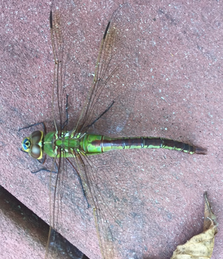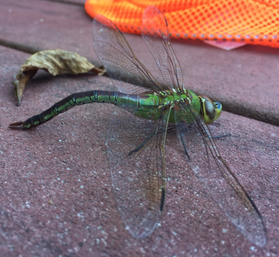 Jeff Stehm Have any of you been seeing swarms of dragonflies in your yard and pastures the past few weeks? This is the first time my wife and I have experienced this phenomenon of nature. I’ve discovered that dragonflies do have a swarming behavior, although scientists aren’t sure why. Two types of swarms exist. The migratory swarm where large masses of dragonflies migrate, flying at higher altitudes. Some of these migratory swarms have been dense enough to show up on weather radar. The other type of swarm that we experienced is a static feeding swarm, where several hundred dragonflies swoop low over a lawn or pasture in figure eight patterns catching bugs. The numbers were thick enough in our yard that all I had to do was swing my butterfly net and bam! I had a dragonfly! She was kind enough to pose for the photo below before flying off to rejoin the group. The iNaturalist group identified her as a Common Green Darner (Anax junius) which is one of the largest dragonflies; males grow up to 3 inches in length and have a 3-inch wingspan. They also migrate great distances from the northern US to south into Texas and Mexico. Neighbors around us have been observing similar swarms. If you interested in further information on this phenomena, I found a great website https://thedragonflywoman.com run by an aquatic entomologist, Christine Goforth from the University of Arizona. Her website contains a wealth of information on dragonfly swarming as well as a page to report a swarm siting as part of a citizen science project she is running. Her descriptions of static swarming matches what I’ve observed – the dragonflies typically appear near dawn or dusk (dusk in my case) because it is thought that dragonflies can see their prey better when the sun is low on the horizon. They appeared very suddenly, fly figure eight patterns over our yard for about an hour, and then are quickly gone. The swarms we have witnessed often start around 5 pm and go until about 6 pm when the sun dips below the trees. Dr. Goforth indicates that dragonflies are attracted to large groups of prey organisms. Once the prey numbers drop or they become less active (e.g. as it gets darker), the dragonflies move on. If the prey returns the next day, the dragonflies likely will too. So far we’ve had about 3-4 evenings of dragonfly visits to our yard. Dr. Goforth says that the swarming behavior is fairly common in many different species of dragonflies, but the chances of a single person seeing more than one or two swarms in their lifetime in a single area can be quite low. The conditions have to be just right for swarms to occur, perfect for both a large number of prey insects and a large number of dragonflies to exist in the same area at the same time. I count myself lucky to have had a once-in-a-lifetime experience. What marvelous creatures.
11 Comments
Fiona Higgins
2/19/2023 12:09:18 pm
Dragon flys swarming in Papaguaya playa Blanca Lanzarote can send footage
Reply
Toni Pennisi
8/13/2023 08:00:57 pm
Dragonfly swarm over my back yard. After heavy rain. 6:30 pm. Overcast but plenty of daylight. No large bodies of water or ponds in immediate area. Overland Park KS.
Reply
Melissa lathrop
9/12/2023 07:37:31 pm
Swarms of dragons flies in Gardner, KS this evening. No rain except some yesterday. This is crazy to watch!
Reply
Linda Schaefer
8/28/2023 08:11:32 pm
We just experienced a swarm of dragonflies…have never seen anything like it. There were several hundred of them at the peak . They just appeared all of a sudden and were low flying ones. Beautiful but also kind of scary
Reply
Kayla Stevensen
9/2/2023 01:06:12 am
Where are you located?
Reply
Lorri T. Mogus
9/4/2023 07:25:19 pm
Thanks for this info.
Reply
Karen Dinelt
9/5/2023 08:37:22 pm
We just experienced a small swarm of dragonflies in our back yard and a few of the neighbours yards. They were doing the figure eight pattern. We live in London, Ontario Canada.
Reply
9/6/2023 03:54:46 pm
We saw dragonflies 2 days straight in port sanilac mi.
Reply
Deb Gilley
9/10/2023 09:07:10 pm
Experienced seeing a static swarm in our backyard tonight, September 10, 2023. At first I thought it was our hummingbirds. There were different sizes and colors. Watched from our windows.Will see if they return Monday night.
Reply
Cynthia
9/11/2023 03:27:18 pm
In all my 65 years I had never seen this until yesterday. At first I thought it was hummingbirds gone insane since I put out 3 feeders every year. On closer examination I realized they were dragonflies. I couldn't figure why till I saw little white thins rising up and being snatched. It was ants hatching from the yard. Very enlightening!
Reply
Jan Smth
9/30/2023 07:56:57 pm
Sept 30: swarm flying overhead. Probably hundreds. Flying quite high, just a few low ones. Fairhope, Al, near Mobile Bay. Migration? Large, brown-bodied ones with brownish gold wings that glint in the sun. Flying at dusk, heading towards the bay
Reply
Your comment will be posted after it is approved.
Leave a Reply. |
Have a blog or blog idea?
Let us know (click) Other Blogs
VA Native Plant Society - click Brenda Clement Jones - click John Muir Laws' Blog - click Megan's Nature Nook - click Categories
All
Archives
September 2023
Blog Administrator:
Kathleen A. VMN since 2018 |

